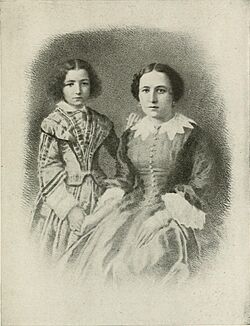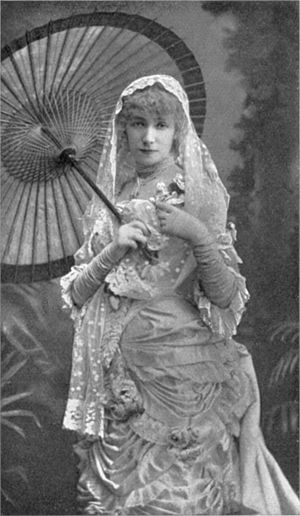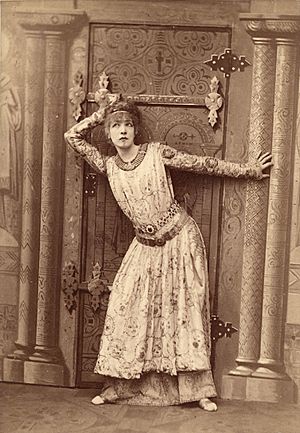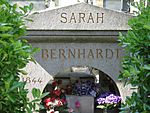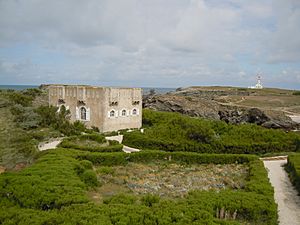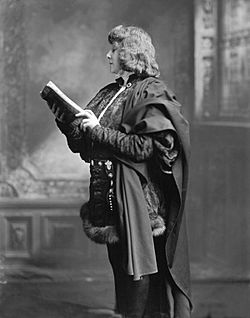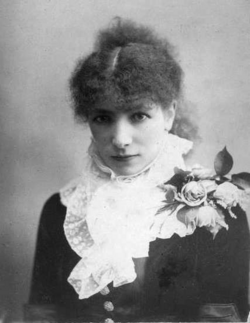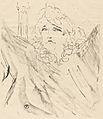Sarah Bernhardt facts for kids
Quick facts for kids
Sarah Bernhardt
|
|
|---|---|

Sarah Bernhardt in June 1877, during a visit to Boston, Massachusetts
|
|
| Born |
Sara-Marie-Henriette Rosine Bernardt
October 22, 1844 |
| Died | March 26, 1923 (aged 78) Paris, France
|
| Years active | 1862–1923 |
| Spouse(s) | Ambroise Aristide Damala (1882–1889) |
Sarah Bernhardt (October 23, 1844 – March 26, 1923) was a French stage actress who has often been called "the most famous actress in the history of the world." Bernhardt became famous on the stages of Europe in the 1870s and was soon working in Europe and the United States. She developed a reputation as a serious actress. Her nickname "The Divine Sarah."
Contents
Early life
Henriette-Rosine Bernard was born in the Latin Quarter of Paris on October 22, 1844. She was the daughter of Judith Bernard and an attorney in Le Havre. Sarah later changed her name to Sarah Bernhardt.
Sarah's mother traveled often and saw little of her daughter. She placed Bernhardt with nannies (called nurses) and in boarding schools. During this time, Sarah's mother continued to make friends with politicians, bankers, generals, and writers. One of her patrons was Charles de Morny, Duke of Morny, a family friend and half-brother of Emperor Napoleon III.
In 1857, Sarah learned that her father had died overseas. Her mother called the family together, including Morny, to decide what to do with her. Morny suggested that she become an actress since she had acted in plays at her schools. He arranged for Sarah to go to the Comédie Française with a group that included her mother, him, and his friend Alexandre Dumas. During the play Britannicus, by Jean Racine, Sarah sobbed so loudly that she disturbed the rest of the audience. After the performance, Dumas called her "my little star."
Morny used his influence to arrange for Bernhardt to audition at the Paris Conservatory, where she studied acting from January 1860 until 1862.
Career
After Bernhardt's time at the Paris Conservatory, Morny used his influence again to get her a place as a pensionnaire at the Théâtre Français. Her first performance with the company on August 31, 1862, was not successful. She experienced stage fright and rushed her lines. Some audience members made fun of her thin figure.
After two more plays with the theater, Sarah did not impress critics or other members of the company, who did not like how quickly she became famous. She was asked to leave when she was eighteen and became the understudy to two of the leading actresses at the Gymnase, another popular theater.
She was not successful at the Gymnase, either, and decided to quit theater to travel. She went to Spain and then, at the suggestion of Alexandre Dumas, to Belgium. Dumas sent letters of introduction with her, which allowed her to mingle with people in the highest levels of society. She attended a masked ball in Brussels where she met the Belgian aristocrat Henri, Hereditary Prince de Ligne. The two became romantically involved, and she gave birth to his child, Maurice Bernhardt, on December 22, 1864, when she was twenty years old.
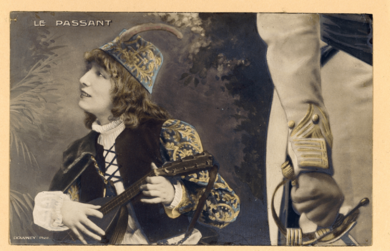
To support herself after the birth of Maurice, Bernhardt returned to acting. In 1866, Felix Duquesnel, director of the Théâtre de L'Odéon (Odéon) on the Left Bank hired her. Her first few performances were not successful; however, she improved as she gained more experience.
Her breakthrough performance was the female lead in Alexandre Dumas's play Kean. Her next success was as a boy troubadour in François Coppée's Le Passant, which played for 150 performances. Emperor Napoleon III requested a performance at his Tuileries Palace. Afterward, the emperor sent her a brooch with his initials written in diamonds.
In 1869, Sarah moved to a large seven-room apartment in the center of Paris. Her mother began to visit and her grandmother, a strict Orthodox Jew, moved into the apartment to take care of Maurice. Bernhardt hired a maid and a cook.
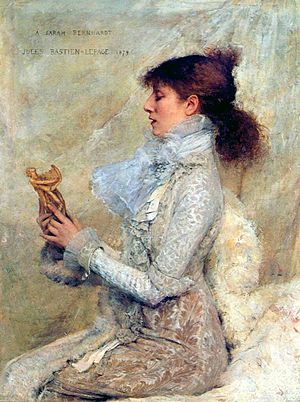
The outbreak of the Franco-Prussian War cut Paris off from news and from its food supply, and the theaters were closed. Bernhardt took charge of converting the Odéon into a 32-bed hospital. She brought her personal chef and convinced her wealthy friends to donate supplies. By the end of the siege, Bernhardt's hospital had cared for more than 150 wounded soldiers.
Many public buildings had been burned or damaged in the fighting, but the Odéon was still intact. Charles-Marie Chilly, the co-director of the Odéon, came to her apartment to announce that the theaters would reopen in October 1871, and he asked her to play the lead in a new play, which premiered on January 16, 1872. The opening night was attended by the Prince of Wales and Victor Hugo.
After a few months, Emile Perrin, Director of the Comédie Française, offered her more money than she was making at the Odéon to return to the Comédie Française. When Chilly would not match the offer, she broke her contract and officially returned to the Comédie Française. Phèdre became her most famous classical role, performed over the years around the world. Even people who did not understand French knew what happened in the play because she made them understand by her voice and gestures.
World Tours
In April 1880, Bernhardt resigned from the Comédie Française. The impresario Edward Jarrett hurried to Paris and proposed that she make a theatrical tour of England and then the United States. She could choose her repertoire and the cast.
Bernhardt's first American tour took her to 157 performances in 51 cities. She traveled on a special train with her own luxurious sleeping car, which carried her two maids, two cooks, a waiter, her maître d'hôtel (head of the dining staff), and her personal assistant, Madame Guérard. She always insisted on being paid in cash. When Bernhardt returned to France, she brought with her a chest filled with $194,000 ($5,882,883 in 2025) in gold coins.
Bernhardt then began a series of world tours. The first was a tour of theaters in the French provinces, Italy, Greece, Hungary, Switzerland, Belgium, Holland, Spain, Austria, and Russia. Just before the tour began, she met Jacques Damala, who went with her as a leading man and then became her husband.
Bernhardt's next world tour included Brazil, Argentina, Uruguay, Chile, Peru, Panama, Cuba, Mexico, Texas, New York City, England, Ireland, and Scotland. She was on tour for 15 months, from early 1886 until late 1887. The tour allowed her to purchase her final home, which she filled with her paintings, plants, souvenirs, and animals.
From then on, whenever she ran short of money (which usually happened every three or four years), she went on tour, performing both her classics and new plays. In 1888, she toured Italy, Egypt, Turkey, Sweden, Norway, and Russia. She traveled the most during 1891–92 tour, going to much of Europe, Russia, North and South America, Australia, New Zealand, Hawaii, and Samoa. While she was touring, she injured her knee when she leaped off a balcony during a play. The mattress she was supposed to land on was misplaced.
Théâtre Sarah Bernhardt
Bernhart's debts were continuing to grow, and as she was preparing to go on another world tour, she learned that a large Paris theater was for lease. She decided to sign a 25-year lease with the city of Paris for the Théâtre des Nations on Place du Châtelet on January 1, 1899. She renamed the 1700-seat theater Théâtre Sarah Bernhardt and began to renovate it.
Bernhardt opened the theater on January 21, 1899. She played her most successful plays, and in 1900, she presented a new play called L'Aiglon. In it, she played Duc de Reichstadt, the son of Napoleon Bonaparte. The 56-year-old actress made the play popular.
Despite the injury to her leg, she continued to go on tour every summer, when her own theater in Paris was closed. In September 1914, Bernhardt discovered that gangrene had developed on her leg. A surgeon amputated her leg almost to the hip, and she was carried in a litter she designed supported by two long shafts and carried by two men.
She continued to act in Paris, despite the loss of her leg. The scenes were arranged for her so that she could sit or supported by a prop with her leg hidden.
On March 21, 1923, she collapsed and never recovered. She died on March 26, 1923. Her Funeral Mass was celebrated at the church of Saint-François-de-Sales. The following day, 30,000 people attended her funeral to pay their respects, and an enormous crowd followed her casket from the Church of Saint-Francoise-de-Sales to Pere Lachaise Cemetery, pausing for a moment of silence outside her theater.
In 1960, Bernhardt was inducted into the Hollywood Walk of Fame with a motion pictures star located at 1751 Vine Street. To date, she is the earliest born person on the Walk (born in 1844), followed by Thomas Edison and Siegmund Lubin.
Belle-Île
After her 1886–87 tour, Bernhardt recuperated on Belle-Île, a small island off the coast of Brittany, 10 miles south of the Quiberon peninsula. She purchased a ruined 17th-century fortress, located at the end of the island and approached by a drawbridge, and turned it into her holiday retreat. She built bungalows for her many visitors, including her son Maurice, her grandchildren, and her friends. She also brought her large collection of animals. Always wrapped in white scarves, she played tennis (under house rules that required that she be the winner) and cards, read plays, and created sculptures and ornaments in her studio. In 1922, when her health declined, she sold her portion of the island and never returned. The Germans occupied the land during World War II. All that is left is the original old fort and a seat cut into the rock where Bernhardt used to wait for the boat that took her to the mainland.
The Art of the Theatre
In her final years, Bernhardt wrote a textbook on the art of acting. She wrote whenever she had time, usually between productions, and when she was on vacation at Belle-Île. Her friend Marcel Berger found the unfinished manuscript, edited the book, and had it published as L'Art du Théâtre in 1923. An English translation was published in 1925.
Vegetarianism
Bernhardt was described as a strict vegetarian (what would later be termed vegan), as she avoided dairy, eggs, and meat. Instead, she ate cereal, fruit, nuts, and vegetables.
Sarah Bernhardt quotes
- "Life begets life. Energy creates energy. It is by spending oneself that one becomes rich."
- "At the Odéon, I was happy. We thought only of putting on plays. We rehearsed mornings, afternoons, all the time. I adored that."
- "I crossed the oceans, carrying my dream of art in myself, and the genius of my nation triumphed."
- "I passionately love this life of adventures. I adore the unexpected."
Interesting facts about Sarah Bernhardt
- Sarah and her mother had rich and powerful friends who helped her get started in the theater business.
- Bernhardt played at least 70 roles in 125 plays throughout her career, both female and male.
- She kept a satin-lined coffin in her bedroom, and occasionally slept in it or lay in it to study her roles.
- She had an exotic pet collection that included a boa constrictor, a lion, a parrot, a puma, two horses, a monkey named Darwin and an alligator named Ali Gaga.
- In 1910, she visited Thomas Edison to record her most famous tragic role, a scene from Jean Racine's 1677 tragedy Phèdre.
- Bernhardt was also a sculptor who experimented with many materials, including bronze, marble, and ceramics.
- Her personal motto was “Quand même,” which translates to “no matter” or “so what?”.
- During a performance Emperor Napoleon III was attending, Bernhardt recited two poems by Victor Hugo who was a staunch critic of Napoleon. The emperor got so upset that he stormed out of the theater, taking his wife, court, and other guests with him.
- When a theater doorman greeted her as “the little Bernhardt,” she broke her umbrella on his head.
- When the doorman retired 20 years later, Bernhardt bought him a cottage in the country.
- At the end of the 19th century, she was known as the most publicized and richest actress.
- In 2001, Martha Stewart shared a recipe for Sarah Bernhardt cookies, claiming they are as “multilayered as their namesake.”
Books
- Dans les Nuages, Impressions d'une Chaise Charpentier (1878)
- L'Aveu, drame en un acte en prose (1888)
- Adrienne Lecouvreur, drame en six actes (1907)
- Ma Double Vie (1907), & as My Double Life:Memoirs of Sarah Bernhardt, (1907) William Heinemann
- Un Coeur d'Homme, pièce en quatre actes (1911)
- Petite Idole (1920; as The Idol of Paris, 1921)
- L'Art du Théâtre: la voix, le geste, la prononciation, etc. (1923; as The art of the Theatre, 1924)
- Sarah Bernhardt My Grandmother (1940)
Roles
- 1862: Racine's Iphigénie in the title rôle, her debut.
- 1862: Eugène Scribe's Valérie
- 1862: Molière's Les Femmes Savantes
- 1864: Labiche & Deslandes, Un Mari qui Lance sa Femme
- 1866: T & H Cognard's La Biche aux Bois
- 1866: Racine's Phèdre (as Aricie)
- 1866: Pierre de Marivaux's Le Jeu de l'Amour et du Hasard (as Silvia)
- 1867: Molière's Les Femmes Savantes (as Armande)
- 1867: George Sand's Le Marquis de Villemer
- 1867: Georges Sand's "François le Champi" (as Mariette)
- 1868: Dumas père Kean (as Anna Damby)
- 1869: Coppée's La Passant, as a male troubador (Zanetto); her first major stage success
- 1870: George Sand's L'Autre
- 1871: Theuriet's Jeanne-Marie
- 1871: Coppée's Fais ce que Dois
- 1871: Foussier and Edmond La Baronne
- 1872: Bouilhet's Mademoiselle Aïssé
- 1872: Hugo's Ruy Blas (as Doña Maira de Neubourg, Queen of Spain)
- 1872: Dumas père Mademoiselle de Belle-Isle (as Gabrielle)
- 1872: Racine's Britannicus (as Junie)
- 1872: Beaumarchais's Le Mariage de Figaro
- 1872: Sandeau's Mademoiselle de la Seiglière
- 1873: Feuillet's Dalila (as Princess Falconieri)
- 1873: Ferrier's Chez l'Avocat
- 1873: Racine's Andromaque
- 1873: Racine's Phèdre (as Aricie)
- 1873: Feuillet's Le Sphinx
- 1874: Voltaire's Zaire
- 1874: Racine's Phèdre (as Phèdre)
- 1875: Bornier's La Fille de Roland
- Dumas fils' L'Étrangère (as Mrs. Clarkson)
- Parodi's Rome Vaincue
- 1877: Hugo's Hernani (as Doña Sol)
- 1879: Racine's Phèdre (as Phèdre)
- 1880: Émile Augier's L'Aventurière
- 1880: Legouvé & Scribe's Adrienne Lecouvreur
- 1880: Meilhac & Halévy's Froufrou
- 1880: Dumas fils' La Dame aux Camélias (as Maguerite)
- 1882: Sardou's Fédora
- Sardou's Théodora (as Theodora, Empress of Byzantium)
- 1887 : La Tosca de Victorien Sardou
- Dumas fils' La Princesse Georges
- 1890: Sardou's Cléopâtre, as Cleopatra
- 1893: Lemaître's Les Rois
- 1894: Sardou's Gismonda
- 1895: Molière's Amphytrion
- 1895: Magda(translation of Sudermann's Heimat)
- 1896: La Dame aux Camélias
- 1896: Musset's Lorenzaccio (as Lorenzino de' Medici)
- 1897: Sardou's Spiritisme
- 1897: Rostand's La Samaritaine
- 1898: Catulle Mendès Medée
- 1898: La Dame aux Camélias (as Marguerite Gautier)
- Barbier's Jeanne d'Arc (as Joan of Arc)
- Morand & Sylvestre's Izéïl (as Izéïl)
- Shakespeare's King Lear (as Cordelia)
- 1899: Shakespeare's Hamlet (as Hamlet)
- Shakespeare's Antony and Cleopatra (as Cleopatra)
- Shakespeare's Macbeth (as Lady Macbeth) (in French)
- Richepin's Pierrot Assassin (as Pierrot)
- 1900: Rostand's L'Aiglon as L'Aiglon
- 1903: Sardou's La Sorcière
- 1904: Maeterlinck's Pelléas et Mélisande (as Pelléas)
- 1906: Ibsen's The Lady From the Sea
- 1906: Mendès' La Vierge d'Avila (as Saint Theresa)
- 1911: Moreau's Queen Elizabeth (as Queen Elizabeth)
- 1913: Bernard's Jeanne Doré (as Jeanne Doré)
Images for kids
-
Bernhardt as Mary Magdalene, painting by Alfred Stevens (1887)
-
Self-portrait 1910 Fondation Bemberg Toulouse
-
Bernhardt with her bust of Medea in her sculpture studio in Montmartre (c. 1878)
-
Debut of Bernhardt in Les Femmes Savantes at the Comédie Française, 1862
-
Sarah Bernhardt in 1864; age 20, by photographer Félix Nadar
-
Playing Joan of Arc in Jeanne d'Arc by Jules Barbier (1890)
-
Poster for Gismonda by Alphonse Mucha (1894)
-
As Melissande in La Princesse Lointaine by Edmond Rostand (1897)
-
Bernhardt in the role of Phedre at the Hearst Greek Theatre at the University of California, Berkeley (1906)
See also
 In Spanish: Sarah Bernhardt para niños
In Spanish: Sarah Bernhardt para niños


